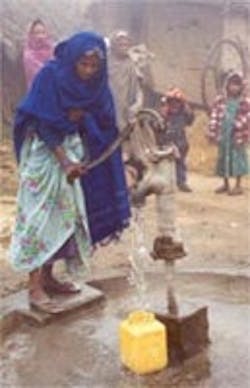Arsenic-Laden Water Poisons People of Nepal
New ground water tests in Nepal have revealed that arsenic-rich tubewells are poisoning the population of the country's southern plains, and experts warn this could spark thousands of deaths in the next decade.
Ironically, thousands of tubewells were installed in the late 80s as a cheap, low technology means of providing drinking water to the people.
Preliminary tests conducted by the government-run National Arsenic Steering Committee and a slew of nongovernmental organizations such as UNICEF and World Health Organization (WHO) reveal people are drinking water containing arsenic levels ranging from 50 to 2600 parts per billion (ppb). The WHO standard for a safe concentration of arsenic is 10 ppb.
The reports indicate that, over time, the affected population could touch 1.7 million.
In 1999, the first survey on arsenic contamination conducted by the Department of Water Supply and Sanitation and World Health Organization (WHO) indicated only 4 percent of the 8,000 tested wells were unsafe.
But in the latest test, 8 percent of the 25,000 tested wells were found to be contaminated.
Anil Pokharel, an expert with nongovernmental organization, Nepal Water for Health (NEWAH), says the findings show there could be 20,000-40,000 arsenic-related deaths after ten to 20 years.
The National Arsenic Steering Committee is now engaged in blanket testing in eight districts of the Terai region in the foothills of the Himalayas. This is the first time such an extensive study is being conducted.
The National Arsenic Steering Committee estimates that about 11 million people living in 22 districts in southern Nepal are under direct threat of arsenic poisoning. "We will have exact data regarding contamination levels after completing our testing by the year end," says Mishra.
Source: OneWorld South Asia
